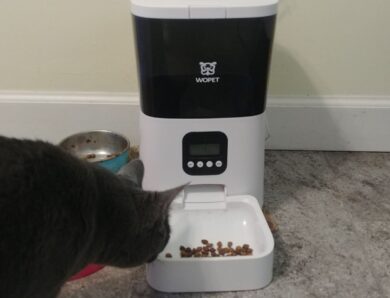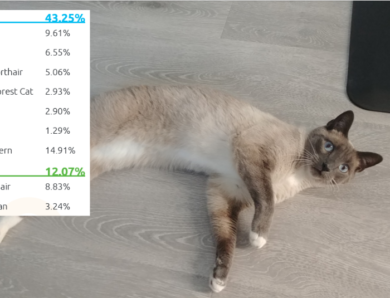
How to Get Rid of Cat Dandruff
It’s not uncommon for cats to suffer from dandruff at some point in their life. For most, it’s not a bother. They often don’t even notice it and it can go away on its own. If it doesn’t, you’ll need to determine what’s causing the problem before you can figure out how to get rid of your cat’s dandruff.
For instance, if your cat’s dandruff is caused by allergies or an unbalanced diet, using an anti-dandruff shampoo or moisturizing her skin will not help. Similarly, if your chubby cat is suffering from an undiagnosed case of diabetes, switching up her diet to one with more omega-3 won’t make a difference.
Diagnosis is always the first step to successfully treating a cat with dandruff.
(As a side note, even if it’s bothering your cat, his dandruff might be a problem for you. Unlike human dandruff, feline dandruff contains an allergen that some people find irritating.)
Here’s everything you need to know about dandruff in cats, from what causes it to how to prevent and treat it.
Cat Dandruff Causes & Treatments
Dryness
The most common cause of dandruff in cats is dry skin, which is most frequently a problem in the winter. Dialed up heat dries out the air, sucking the moisture out of your kitty’s skin.
While dry skin alone is more of an annoyance than anything it can be an issue if your cat is bothered enough to take to scratching to relieve the discomfort. Excessive scratching can damage their skin and create open sores at risk for infection.
One or two humidifiers spread around your home can raise the humidity levels, making dry skin less likely.
Shampoos, Conditioners and Moisturizers
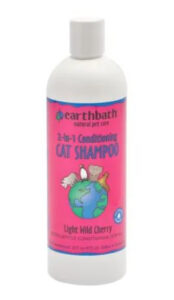
Before investing in a cat-specific shampoo or moisturizer, spend some time brushing your cat. Most cats love being brushed ad it’s a simple way to distribute his natural oils throughout his fur and clean his it of flakes. Do this for three days a week for two to three weeks.
If regular brushing doesn’t make a difference, it may be time to look into a cat dandruff shampoo, conditioners and/or a skin moisturizer. Just don’t overdo the shampooing; too much will strip the moisturizing oils out of her fur, rather than supplement them.
If a bath is impossible, look for moisturized wipes that are easy to use.
And, no, you cannot use Head & Shoulders on your cat, even a watered-down version. It is not formulated for cats and will strip your kitty’s fur and skin of their essential oils, making the problem worse.
Parasites
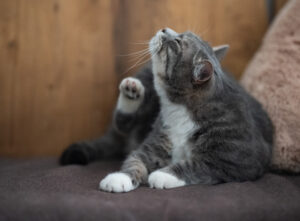
Parasites are another possibility. Cheyletiella mites, for instance, can cause a skin condition called cheyletiellosis that results in excessive dandruff and itchiness. It is highly contagious to other cats (as well as dogs, rabbits, and even people). Most cats with cheyletiellosis will display excessive grooming and scratching. A dip or special shampoo is often required to rid your cat of the mites. If you suspect your kitty has cheyletiellosis (you can usually see the mites crawling over your cat’s fur!), a trip to the vet is a must.
Flea and lice bites can also cause skin irritation that can present as dandruff.
Obesity & Disease
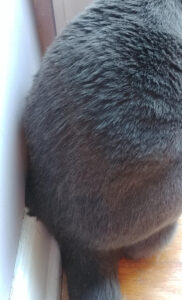
Chubby cats are prone to dandruff, particularly on their lower back and at the base of their tail. These are some of the harder spots for a cat to reach when grooming. Extra padding makes it that much harder for your overweight cat to reach those spots.
Additionally, obesity can lead to life-threatening illnesses, like diabetes or hyperthyroidism, both of which can cause dandruff.
If the dandruff is bothering you, you can purchase special wipes or give your kitty a bath. But the best thing you can do is help your fat cat lose weight, especially if his weight has resulted in an illness. It’ll be better for everyone in the long run.

Allergies
Cats can be allergic to a number of things around your house. If this is your fur baby’s firsts bout of dandruff, double check to see if you changed anything he might have been exposed to. Did you try a new food? Wash your kitty bed in a new detergent?
If you think a new product might be to blame, eliminate it from your routine and see what happens. If the dandruff clears up, you’ve got your answer.
Insufficient Diet

Dandruff can also be a sign that your cat’s diet is lacking in omega-3 fatty oils, which sound like they’d be bad, but are actually important for the health of your cat’s skin and fur.
Check the nutrition labels on your cat’s food. Does it contain salmon, mackerel, trout, or fishmeal? Or has it been enriched with DHA (docosahexaenoic acid) or EPA (eicosapentaenoic acid), both of which are omega-3 acids?
If your cat’s preferred food is short on omega-3, you might want to consider switching to another brand or adding an omega-3 supplement to her daily regimen. Always check with your vet before adding a supplement to make sure you’re giving your kitty the right dosage.
Planning on a getaway and need to hire a cat sitter? Find out what questions you should ask before hiring a cat sitter.


